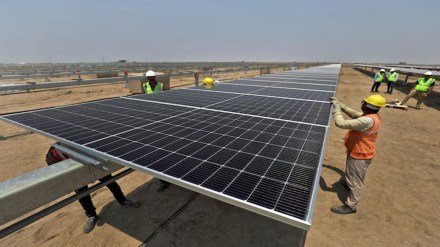By Siddharth Pai
From Chatgpt to Gemini, artificial intelligence (AI) has taken centre stage in public discourse, with headlines touting its transformative potential. Yet, while we marvel at these advancements, another technological revolution has been quietly unfolding — one that may be even more critical to our future: solar energy.
Solar power, long considered the cornerstone of a sustainable energy future, has undergone profound changes in recent years, making it far more efficient and affordable. The latest breakthroughs, including experimental technologies like tandem solar cells, promise to boost solar efficiency further. And yet, as we focus our collective attention on the allure of AI, the extraordinary progress in solar energy has largely flown under the radar.
The most remarkable aspect of solar energy’s recent trajectory has been its plummeting costs. Over the past decade, the price of solar power has fallen by an astounding 89%. This exponential decrease is mainly due to improvements in manufacturing, economies of scale, and technological innovations. Consider that in 2010, the average solar photovoltaic (PV) panels cost around $3.86 per watt. Today, that figure has dropped to around $0.20 per watt or lower in some regions.
This price reduction has made solar energy increasingly competitive with, and in many cases cheaper than, traditional fossil fuels. Utility-scale solar farms often produce enough electricity to make solar one of the cheapest energy sources available. For consumers, this means that the barriers to installing solar panels — particularly high upfront costs — are becoming lower and lower. Even large corporations like Amazon, Apple, and Google have made significant solar investments, recognising its environmental and economic benefits.
Affordability is only one piece of the puzzle. Efficiency is the next frontier, the measure of how much sunlight can be converted into usable electricity. One of the most exciting developments in solar energy is the emergence of tandem solar cells. While traditional solar panels typically use silicon-based cells, which have a theoretical efficiency limit of about 29%, tandem solar cells stack two or more layers of different materials on top of each other, each absorbing different parts of the solar spectrum. This layered approach captures more energy, potentially pushing efficiency limits beyond 40%.
Perovskite — a crystal structure that has become the darling of solar researchers in recent years — is one of the key materials paired with silicon in tandem cells. Perovskite materials are incredibly efficient at converting sunlight into electricity, and when used in tandem with traditional silicon, they can capture wavelengths of light that silicon alone cannot. The result? Higher energy yields without increasing the panel’s footprint.
Tandem solar cells have already demonstrated efficiencies of 34% in lab settings, and many experts believe that commercial viability is just around the corner. The respected journal Nature has recently published research on the material. While the technology is still experimental, its potential is enormous. Imagine a world where solar panels on your roof generate nearly twice the electricity they do today, making solar energy more productive and cost-effective than ever. In addition to tandem cells, other experimental technologies are also pushing solar efficiency forward. For example, bifacial solar panels, which capture sunlight from both the front and back sides, can increase energy output by 20%. Similarly, solar tracking systems, which follow the sun’s trajectory throughout the day, can improve efficiency by up to 30% compared to stationary panels.
Advancements in energy storage, which has historically been a bottleneck for solar energy, are also being made. New battery technologies like lithium-sulphur and solid-state batteries promise to store solar power more effectively, allowing homes and businesses to use stored solar energy even when the sun isn’t shining. In short, solar energy is undergoing a quiet revolution that could reshape the global energy landscape in ways we can’t yet fully comprehend.
And yet, despite these groundbreaking developments, solar energy has taken a back seat in the public consciousness. Instead, much of the world’s attention has shifted to the dazzling promise (and sometimes dubious risks) of generative AI. Indeed, AI has earned its spotlight. However, the current public discourse treats AI as the be-all and end-all of technological advancement. Daily, we see headlines about how AI will change work, creativity, and our ethical frameworks. Meanwhile, transformative advancements in solar energy barely make a blip on the radar.
The climate crisis is, without a doubt, the most pressing existential threat humanity faces. While AI may disrupt industries, solar energy could help save the planet. The more efficient and affordable solar energy becomes, the faster we can transition away from fossil fuels and mitigate the worst impacts of climate change. Also, the economic potential of solar energy is enormous. By 2050, the International Energy Agency projects that solar will be the largest source of electricity globally. The industry already employs millions and generates billions of dollars in economic activity each year. If we continue prioritising research and development in solar technology, the economic benefits could be even greater.
Finally, while AI is essentially a tool for augmenting existing processes, solar energy represents a fundamental shift in how we power our world. It’s not just a technological breakthrough, it’s a societal one. Transitioning to solar means rethinking our entire energy infrastructure, from homes and cities to transportation and industry. In short, solar energy has the potential to reshape our world in ways that are perhaps even more profound than AI.
Ultimately, we must balance our excitement for generative AI with a clear-eyed focus on the equally important, if quieter, solar energy revolution. Because while AI may be training to predict the future, solar energy is building it.
The Author is a technology consultant and venture capitalist.
Disclaimer: Views expressed are personal and do not reflect the official position or policy of FinancialExpress.com. Reproducing this content without permission is prohibited.
